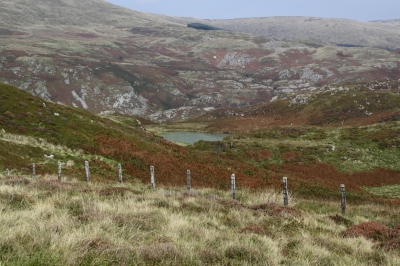 It was supposed to be a hillfort visit, but I was fed up of driving to where I wanted to walk, so two weeks ago I did a route that I could do by leaving the house on foot, taking the Panorama walk to the lake and back again, which takes a route across the ridge. I had planned to take the longer route via Happy Valley, but was tired after an iffy night, so took the shorter route, which also allowed me to get a look at the rear end of Foel Caethle, a hillfort the lies between Tywyn and Aberdovey, from a slightly higher viewpoint than the peak of Caethle itself.
It was supposed to be a hillfort visit, but I was fed up of driving to where I wanted to walk, so two weeks ago I did a route that I could do by leaving the house on foot, taking the Panorama walk to the lake and back again, which takes a route across the ridge. I had planned to take the longer route via Happy Valley, but was tired after an iffy night, so took the shorter route, which also allowed me to get a look at the rear end of Foel Caethle, a hillfort the lies between Tywyn and Aberdovey, from a slightly higher viewpoint than the peak of Caethle itself.
 If you haven’t done it before, it’s super-easy to follow the Panorama on the Ordnance Survey map. You pass through a number of gates (five in total, I think, but more if you choose not to balance your way across cattle grids) so you will need to take hand gel and/or gloves. Just walk up Copper Hill Street from Chapel Square, and after about five minutes take the right turn into Mynydd Isaf, which is a development of 1960s bungalows. Follow this all the way to the top and at the crossroads go left. Keep an eye out in the verges too, for wild flowers and small butterflies. The harebells are particularly worth seeing – more prolific in August but with many still left in September. The tormentil is prolific at this time of year, and the last of the little cornflower-blue Sheep’s-bit are still around. There were lots of red admiral butterflies around, although none of them were obliging enough to settle to have their portraits taken.
If you haven’t done it before, it’s super-easy to follow the Panorama on the Ordnance Survey map. You pass through a number of gates (five in total, I think, but more if you choose not to balance your way across cattle grids) so you will need to take hand gel and/or gloves. Just walk up Copper Hill Street from Chapel Square, and after about five minutes take the right turn into Mynydd Isaf, which is a development of 1960s bungalows. Follow this all the way to the top and at the crossroads go left. Keep an eye out in the verges too, for wild flowers and small butterflies. The harebells are particularly worth seeing – more prolific in August but with many still left in September. The tormentil is prolific at this time of year, and the last of the little cornflower-blue Sheep’s-bit are still around. There were lots of red admiral butterflies around, although none of them were obliging enough to settle to have their portraits taken.
 This takes you uphill, and you are instantly in the countryside, passing a farm on your right, with views over Aberdovey to your left. Just keep walking, not forgetting to turn round and see the gorgeous views over the estuary as you go higher, until you reach a right turn, with the chalet park ahead of you. It’s about an hour and 15 minutes from here to the fork for Llyn Barfog (and the same on the return leg), with gorgeous views over Happy Valley and the hills to the left, and some views over the glistening estuary to the right, which looks completely different depending on whether the tide is in or out.
This takes you uphill, and you are instantly in the countryside, passing a farm on your right, with views over Aberdovey to your left. Just keep walking, not forgetting to turn round and see the gorgeous views over the estuary as you go higher, until you reach a right turn, with the chalet park ahead of you. It’s about an hour and 15 minutes from here to the fork for Llyn Barfog (and the same on the return leg), with gorgeous views over Happy Valley and the hills to the left, and some views over the glistening estuary to the right, which looks completely different depending on whether the tide is in or out.
 The tarmac eventually runs out at the farm, at which point you pass through two gates and onto a deeply incised farm track with a drystone wall on your right and views now mainly over the estuary, with a slope of gorse and heather rising to your left.
The tarmac eventually runs out at the farm, at which point you pass through two gates and onto a deeply incised farm track with a drystone wall on your right and views now mainly over the estuary, with a slope of gorse and heather rising to your left.
You may want to pause and puzzle over Arthur’s Stone, marked with a dignified slate rectangle, a bit like a headstone, inscribed with the words Carn March Arthur (the stone of Arthur’s horse, which in some legends is called Llamrai). It has a role in the slaying of the story of the monster, called the afanc, that lived in the lake, which I’ve summarized below, and what you’re looking for is the hoof imprint of the horse of King Arthur. Good luck with that.
 Carrying on a short way downhill, with views over the hills ahead, an array of colours as they fade into the distance, you go through an open gate (shown right) and the footpath for Llyn Barfog is just on the left. It is easily missed – there is a wooden stake marking it (shown immediately below), but no signpost. It is, however, quite well worn so if you keep an eye open you should be okay. This takes you round the foot of a small hill rise and leads you directly to the lake, about a 10 minute walk. I sometimes follow the sheep tracks to the top of the rise instead and then make my own way down, because the view down onto the lake is great, but the going isn’t easy – the sheep tracks are very narrow and the surface all around consists of big, dense clumps of heather that are not easy to walk between.
Carrying on a short way downhill, with views over the hills ahead, an array of colours as they fade into the distance, you go through an open gate (shown right) and the footpath for Llyn Barfog is just on the left. It is easily missed – there is a wooden stake marking it (shown immediately below), but no signpost. It is, however, quite well worn so if you keep an eye open you should be okay. This takes you round the foot of a small hill rise and leads you directly to the lake, about a 10 minute walk. I sometimes follow the sheep tracks to the top of the rise instead and then make my own way down, because the view down onto the lake is great, but the going isn’t easy – the sheep tracks are very narrow and the surface all around consists of big, dense clumps of heather that are not easy to walk between.
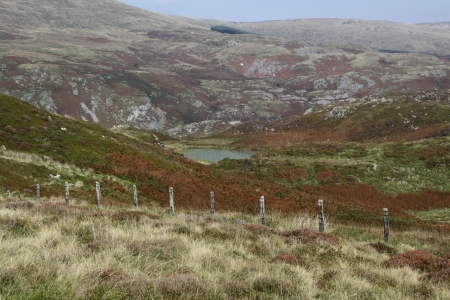 However you arrive at it, the lake always manages to be a bit of a surprise, so high up and so intensely blue. Each time I visit, I half expect it to have vanished. I’ve sadly never managed to catch it when the water lilies and other water flowers are in bloom, but today the lily pads were deeply green against the blue water and gave it a rather exotic feel, and the water glowed and sparkled in the sunlight. I sat on a handy outcrop of quartzite for a while to enjoy the views and the silence.
However you arrive at it, the lake always manages to be a bit of a surprise, so high up and so intensely blue. Each time I visit, I half expect it to have vanished. I’ve sadly never managed to catch it when the water lilies and other water flowers are in bloom, but today the lily pads were deeply green against the blue water and gave it a rather exotic feel, and the water glowed and sparkled in the sunlight. I sat on a handy outcrop of quartzite for a while to enjoy the views and the silence.
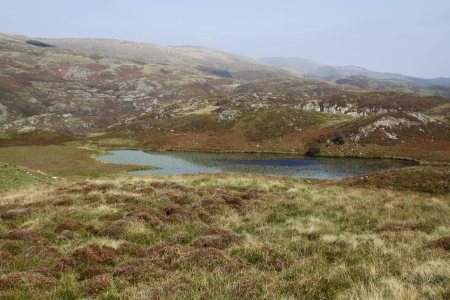 The name “bearded” is thought to relate to the vegetation around its edges. Unlike Arthur’s horse’s stone, one really could imagine this being a source of myth and legend, and indeed, there are at least two. One concerns the water monster known as the afanc, which is associated with other lakes too, a legend that eventually had an Arthurian spin on it. Here’s the main thrust of it. The afanc was the cause of flooding and other damage to good land. In some versions he lives in a cave and slays three princes a day who come to kill him, but they are resurrected, and the cycle repeats. In the case of Llyn Barfog, the afanc must be lured from the water by a heroic figure who will finish him off, and this hero eventually becomes Arthur. Arthur and his horse pull the monster from the lake, finishing it off, and one of the horse’s hooves leaves its imprint in the Carn March Arthur. See more on the Coflein website, where you can read a Llyn Barfog legend of green-clad fairies, two cows in love and a greedy farmer.
The name “bearded” is thought to relate to the vegetation around its edges. Unlike Arthur’s horse’s stone, one really could imagine this being a source of myth and legend, and indeed, there are at least two. One concerns the water monster known as the afanc, which is associated with other lakes too, a legend that eventually had an Arthurian spin on it. Here’s the main thrust of it. The afanc was the cause of flooding and other damage to good land. In some versions he lives in a cave and slays three princes a day who come to kill him, but they are resurrected, and the cycle repeats. In the case of Llyn Barfog, the afanc must be lured from the water by a heroic figure who will finish him off, and this hero eventually becomes Arthur. Arthur and his horse pull the monster from the lake, finishing it off, and one of the horse’s hooves leaves its imprint in the Carn March Arthur. See more on the Coflein website, where you can read a Llyn Barfog legend of green-clad fairies, two cows in love and a greedy farmer.
The return trip is just as good. The wind had got up a bit, so it was nowhere near as hot. On the entire walk I saw only six people, three separate couples. That surprised me,because at this time of year it is usually quite popular with walkers.




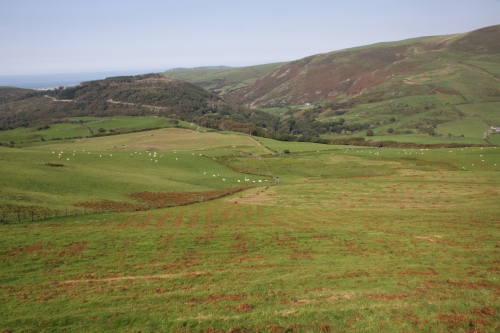
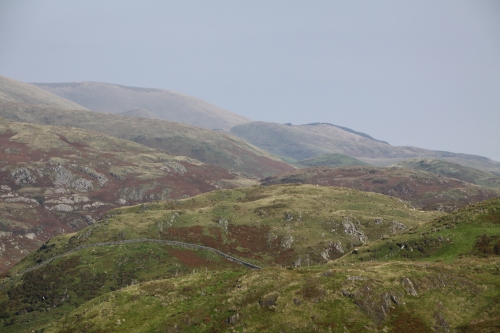
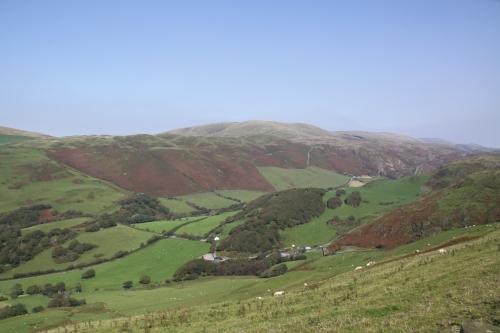





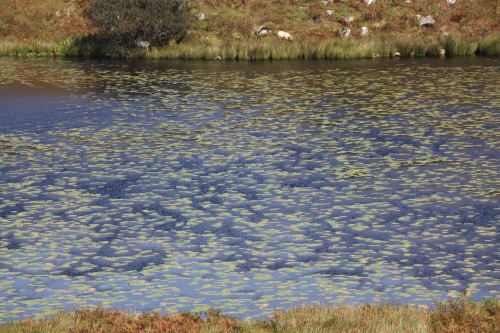




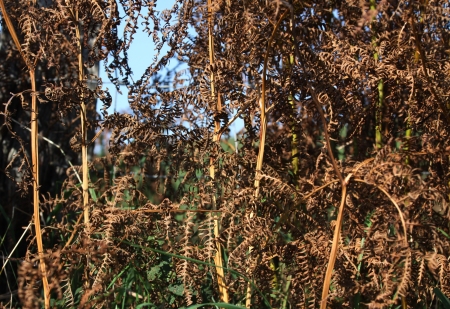
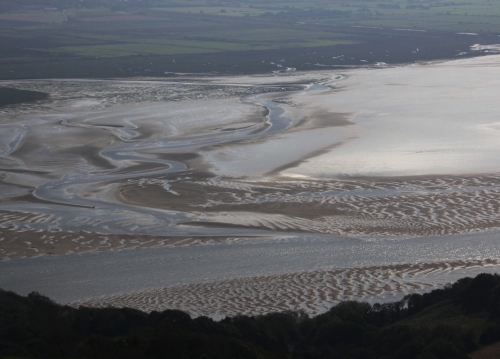
Have you also been to the echo valley that lies just beyond Llyn Barfog ?
LikeLiked by 1 person
hillfort. sounds challenging
LikeLiked by 1 person
Many years ago I worked at the Outward Bound School,as a project with my group of students we took a small rowing dinghy and did a survey of Bearded Lake, to my regret I cannot remember the total details but it isn’t that deep and fortunately we didn’t find a dragon.
LikeLike
Sufficiently deep for it not to dry up in hot summers. That’s a really interesting thought. I wonder how deep the lake below Cadair Idris is? Someone must have done that survey. I’ll have a potter on Google later on. Perhaps the dragon hibernates in the summer 🙂
LikeLike
Regarding the “lake below Cadair Idris”, I think Llyn Cau and Llyn y Gadair are fairly deep, while Llyn y Gafr is quite shallow.
LikeLike
Google suggests Llyn Cau is almost 50m deep, while Llyn y Gadair is 13m.
LikeLike